|
ryansumo
|
 |
« Reply #20 on: March 21, 2014, 05:52:11 PM » |
|
Haha, I never thought of it as a CHuck Norris Turtle! Unfortunately we're back to the drawing board in terms of game design, so it'll be a while yet until we have a demo up. I'll try to get some gameplay GIFs of our prototypes though, to whet your appetite. In the meantime, some more concept art! 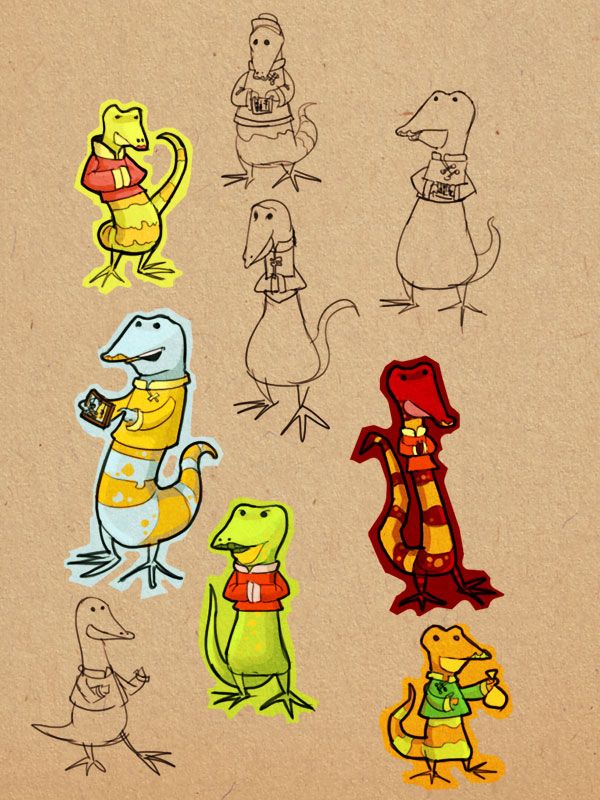 Pirate/merchant/smuggler Lizard. This character draws on our complex relationship with successful Chinese immigrants, and a semi historical pirate that tried to create his own kingdom in the Philippines (he failed, btw). 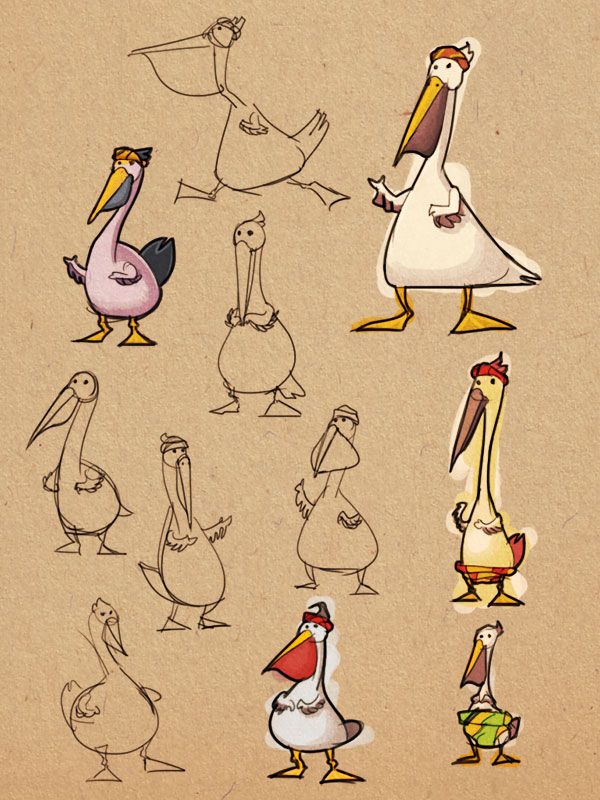 Chieftain Pelican. He represents the interests of the tribal villages outside of the city. He constantly worries about how modernization is affecting their way of life, and where he is going to get his next fish. That's the first Chuck Norris Turtle I've ever seen in my life... this game is insanely hilarious already and the artworks are brilliant. So dying to see it alive soon guys!
|
|
|
|
|
 Logged
Logged
|
|
|
|
|
ryansumo
|
 |
« Reply #21 on: March 23, 2014, 08:17:04 AM » |
|
We're still super excited about our inclusion into the latest Tigsource Devlog Magazine. Games like Papers,Please have definitely given us the courage to make a game that deals with a fairly uncommon subject matter for games, and so to be mentioned on the same magazine is really quite a thrill. Ultimately this will only push us to work harder to make the best game we can. Unfortunately right now a lot of the work we're doing is tinkering with the design, so there's not much to show except for the concept sketches I've been sharing with you. So in the meantime here's a couple of GIFs of the prototype we showed off at Bitsummit. With the changes we're planning these GIFs will probably not represent the final product at all, but I guess that's what a devlog is for!  This is the basic sortie, where you match voter's concerns to the issues you talk about. In this case, they're interested in employment but not in birth control. This is the basic sortie, where you match voter's concerns to the issues you talk about. In this case, they're interested in employment but not in birth control. If you're losing their attention, bring in the entertainers! If you're losing their attention, bring in the entertainers! Or if you're feeling cheap, call in some goons to scare them back to the pulpit. Or if you're feeling cheap, call in some goons to scare them back to the pulpit. |
|
|
|
|
 Logged
Logged
|
|
|
|
|
ryansumo
|
 |
« Reply #22 on: March 29, 2014, 05:54:10 AM » |
|
Julius just released a post on some of the research he's been doing on how to win elections, based on a guide written by local campaign managers.I've been researching local elections lately. We're still tweaking the game design a lot and the last thing we want is to mis-represent our subject matter. So my next few posts will be about how to win a local election followed by how it translates into gameplay. WinnabilityBefore you even think about running for office, the first thing you should do is gauge your winnability.  "Do you have a realistic chance in winning this election, Mr. President?" If you don't think you can win, then chances are the voters won't either. The winnability question is important because it becomes the basis of your campaign strategy. Is it because a lot of people like you or a lot of people hate your opponent or you have a massive war chest or a command of a large block of voters? Consider Pichay's senatorial bid. He had a massive war chest but he was relatively unknown so most of his ads are aimed at getting him into people's radar (the cheesy pechay ads). Ryan: A little explanation here. The Chinese Cabbage framing Pichay is called "Pechay" in the Philippines, hence the humor. Also, I'm rather amused that Pichay, whose first name is Prospero, had a massive war chest. Why else would you compare yourself to a vegetable? A more scientific measure for winnability is a combination of voter awareness (do they know you?) and trust (do they trust you?). Surveys to answer these are conducted before a campaign starts. Don't even think of running for office with a <60% awareness rating. Throughout the campaign, you resurvey the voters to measure your effectivity. Self-fulfilling ProphecyIn the 2013 elections, one of the reasons the senatorial candidates made a big deal out of the TV surveys is because of the self-fulfilling nature of winnability. The more voters think you are going to win (regardless of issues or platform) the more likely that they'll vote for you. Most people don't want to waste their votes on a weak candidate. Majority of your ground campaign is focused on creating an aura of winnability. Your campaign posters have to be bigger, campaign jingles catchier, and your sorties more packed. Candidates will even bring in audience members from other districts just to fill the seats.  Everyone is a winner, the printers specially. Winnability can also result to defection. Some supporters might switch sides if they doubt the chances of their candidate. Winnability!= VotesWhile increasing winnability is the driving force of your campaign, it might not translate directly into votes come election day. Because 3rd world! Certain districts might have historically low voter turn out. Your opponent might actively discourage voter turn out in one of your districts (ex. by bribing public transport to go on strike, or inviting them to a beach party with a sexy starlet, whatever stops people from going to the precinct). This is why "special arrangements" is a big item in a candidate's budget. The last two days before the election is all about making sure winnability translates into votes (or the reverse if you're on the losing side). Even with a clear advantage, the winnable candidate must defend his voter base against intimidation and bribery. While a losing candidate must be prepared to do everything he can to win. Because even if you cheated, the election court is so slow you'd have served your full term by the time they reach a verdict! Because 3rd world!
|
|
|
|
|
 Logged
Logged
|
|
|
|
|
ryansumo
|
 |
« Reply #23 on: April 22, 2014, 07:05:32 PM » |
|
I'm back with some more concept sketches for you, this time of the Goat and Dog Kapitan.  The goat Kapitan is based on some of the indigenous tribes of the Philippine highlands. I say "some of" because there are many of these indigenous tribes, and I wanted to represent them overall and not one specific tribe. These tribes are some of the earliest inhabitants of the Philippine islands. Similar to their aboriginal cousins in South America, they face many difficulties integrating into modern society, and this goat Kapitan reflects those issues.  The dog Kapitan is quite obviously based on the religious groups in the Philippines. Religion, for good and ill, continues to play a very strong role in Philippine society. While there is technically a separation between Church and state, various religious groups hold a lot of sway over their parishioners, and inevitably sway politicians. In fact, in 2004 and 2010 Bro. Eddie Villanueva ran for the President of the Philippines (finishing a distant fifth). Religion is at best a sticky topic, and we don't want it to be a distraction from the main game. To heighten the sense of satire (at this point I'm starting to think we should call the game an allegory) I've decided to create a fictional religion whose symbol is a bone. Surely that can't be taken too seriously by anyone.  I've also taken the initial Kapitan Sketches and created more polished final art from them. As you can see from this comparison between the original rushed in-game art and the new Kapitans, there's a bit of differences in terms of look and polish, which means I'll have to revisit these older sprites at some point (really boring but necessary work).  Lastly, in our dialogue screens with the Kapitans, I'm also hoping to have the Kapitans react emotionally to what you say to them. Their emotions will be pretty binary, but I wanted an "active" angry versus a "passive angry" and vice versa. The "active" images will show up when you initially displease a Kapitan, after which they will settle into the "passive" image. That's it for now. In the next few weeks I'll be experimenting with animation in spriter to see if there's any point to moving to rigged animation versus straight up hand drawn keyframes. Stay tuned for more! |
|
|
|
|
 Logged
Logged
|
|
|
|
|
ryansumo
|
 |
« Reply #24 on: May 03, 2014, 05:35:01 AM » |
|
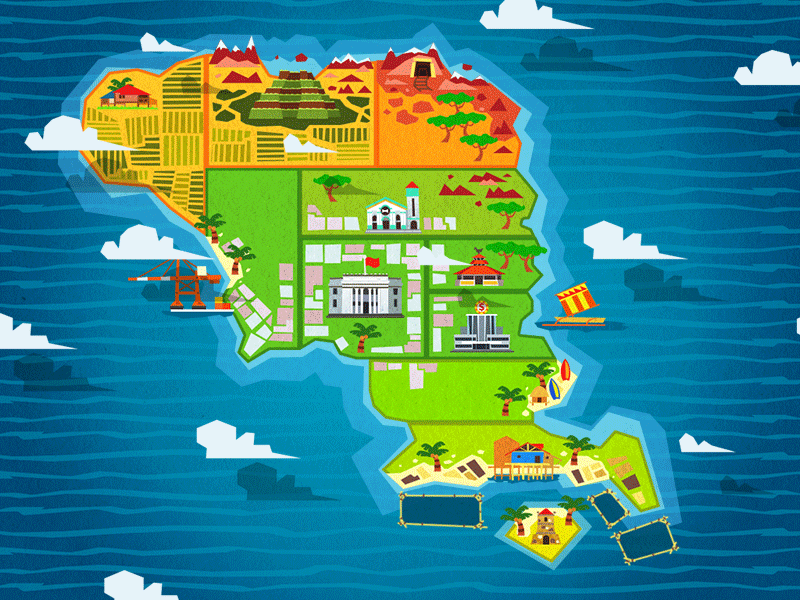 Hi all, had some medical issues so just a quick blog update to show you what I've been doing with the map. Compared to the previous versions of the map I've added some new landmarks and also experimented a little bit with some animations. That's all for now, more next week! |
|
|
|
|
 Logged
Logged
|
|
|
|
|
ryansumo
|
 |
« Reply #25 on: May 06, 2014, 07:13:12 PM » |
|
THE GEOGRAPHY OF SUMMER ISLAND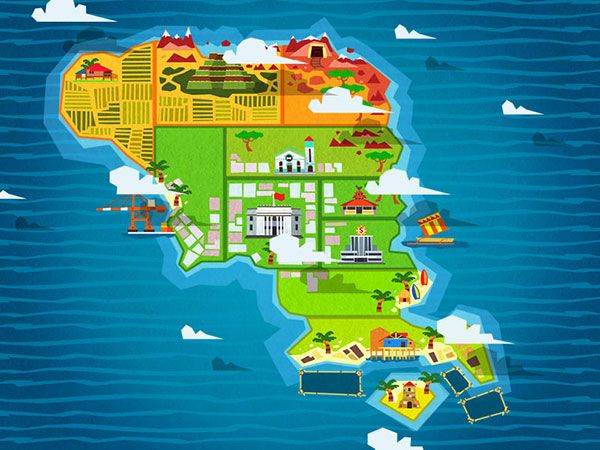 I wanted to expand on my previous blog post where I showed you guys the current state of Party Animals’ world map. The map depicts Summer Island, a fictional tropical island nation. The shape of Summer Island is actually loosely based on Samar Island in the Philippines, which is where Julius is from. Fittingly, it was Julius’ idea to name it Summer Island. It’s a play on words because the way Filipinos usually pronounce the word Summer is “Sah-mehr”, very similar to how you would say Samar. On a side note, I want to mention how interesting it is how much geography matters to people. The landmass of Summer Island is actually very loosely based on Samar Island. I did that intentionally as sort of an Easter Egg for Julius, but as soon as he saw it he said “Hey, it’s Samar!” His cousin, a fellow Samarite (Samarian?Samarista?) also saw it right away. Having lived in Metro Manila for all my time in the Philippines, I find it impossible to see the country as its’ individual parts, but I suppose it matters more when you actually live there. I wonder how many people in the US have their home state’s geometry burned into their memories? Summer Island is divided into 11 Districts, (we may call them something else in the future, like provinces or states) each of which has its own personality. That personality is personified by the district Landmark and Kapitan. The Kapitan is the leader of the district. Sometimes they are the locally elected official, but in other cases they are simply the person who has the most influence over the people, making it important to sway them to your side. I will talk about the Kapitans and how the player deals with them in another post, but I thought I would go over a few of the district Landmarks first, and where I drew inspiration for them. THE KAPITOLYO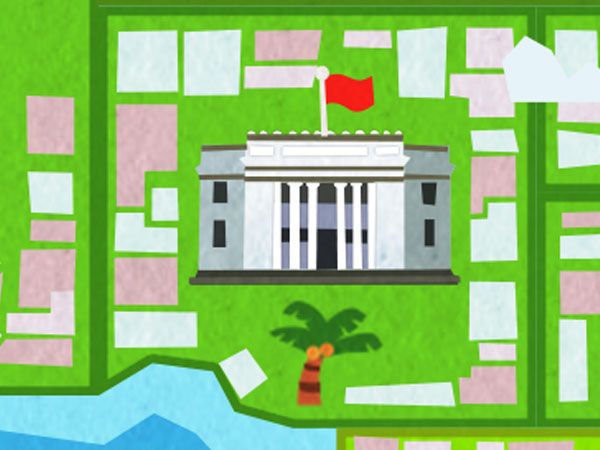 The Kapitolyo or Capitol, is the center of Political life on the island. It’s the only occasion in the game where the Landmark represents the district but has no direct correlation to the district’s Kapitan. You might find it odd that a US style Capitol is the center of power in a tropical island, but in the context of the Philippines it makes perfect sense.  From 1898 to 1946, the Philippines was a colony of the United States of America. Leaving aside the obvious downsides of colonization, the US imported many ideals from their country to ours, including Basic Education, Basketball, and Neoclassical Architecture. Daniel Burnham, who had a had a hand in the planning of the cities of Chicago and San Fransisco, also laid out a plan for Manila, the Philippine Capital. His vision for the Philippine Capital was only partially realized, but it set the template for the provincial Capitols of the Philippines, including the Negros Occidental Capitol, seen above. 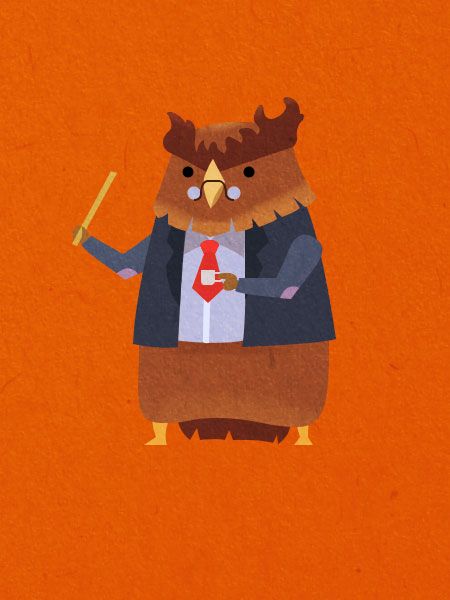 The Kapitan of this District is the Qwl, who represents the Intelligentsia of the island. I’m not entirely sure yet whether the Owl will be a professor or perhaps a lawyer, but he needs to represent the desires of the elite of the island. The elite are often quite insulated from society and cannot seem to grasp the idea of being poor, but they also have better educations and relatively wider scope of the issues on the island. RICE TERRACES The Rice Terraces of the Philippines are a National Treasure as well as being a UNESCO World Heritage site. Rice cultivating cultures have existed in the South East Asian region for centuries, and in mountainous regions many of these cultures devised this unique terracing method to plant and harvest rice. This terracing is not unique to the Philippines however, as rice terraces also exist in China, Vietnam, Bali, and a number of other countries. In the Philippines, the rice terraces of the Cordilleras are one of the few distinctive pre-colonial structures that remain to this day. 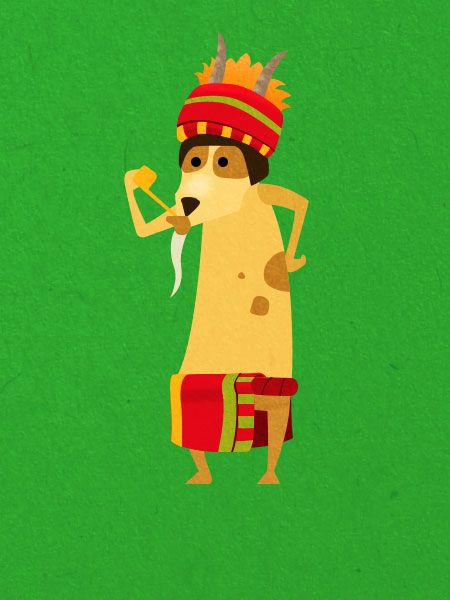 The Kapitan of this District is the Goat, who is a tribal elder that represents the desires of tribal minorities in the modern world. The Tribal leader is fiercely protective of his culture and increasingly embittered as he sees the younger generation of his tribe migrating to the city center and abandoning the old ways. While very serious about his duties, he does like smoking tobacco and other... dried leaves in his pipe. SABONG (COCKFIGHTING) ARENA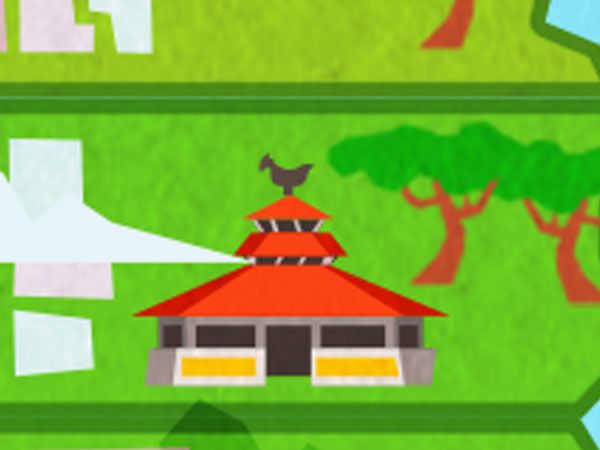 Okay children, try to contain yourselves. I didn’t mean THOSE cocks. Although I’m sure there’s a little of that going on since Sabong or Cockfighting is a male dominated sport. Cockfights are as old as time, and the first cockfights supposedly occurred 6000 years ago in ancient Persia and India, and continue on to this day in a variety of countries across Asia. It used to be popular in Europe and even the USA until the practice was legally banned. In the Philippines, one cannot go 10 minutes outside the city limits without seeing the cage of a fighting cock (heck, there are even some in the highway overpass right outside our home). 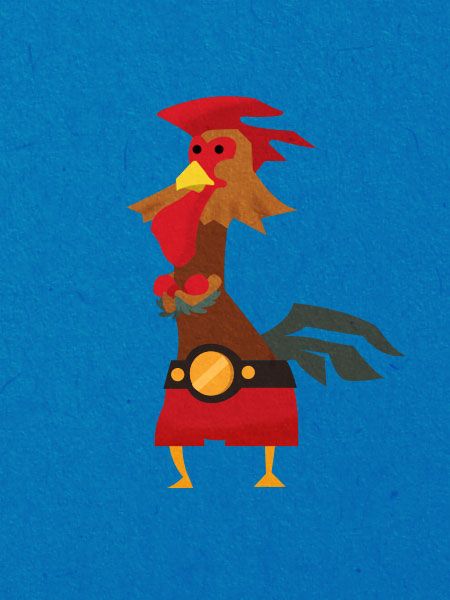 I had a bit of a moral dilemma about whether or not to include a Sabong Arena, since I personally find the sport distasteful. Also, what sense would it make in an island populated by sentient animals that there would be non-sentient roosters fighting in a bloodsport? Then I had a flash of inspiration. The Philippines loves cockfights. It also loves boxing. Why not make the cocks boxers? And so the Rooster Kapitan was born. It’s no secret Filipinos love our sports heroes. Heck, it’s even rumored that boxer Manny Pacquiao has his eye on the presidency. So it made total sense to have a prizefighting Rooster Kapitan heading one of the districts. The Rooster Kapitan feels for the less fortunate, from whose ranks he came. He dislikes politics, and if he could would reform government so that bills could be passed depending on 12 rounds in the ring. CASINO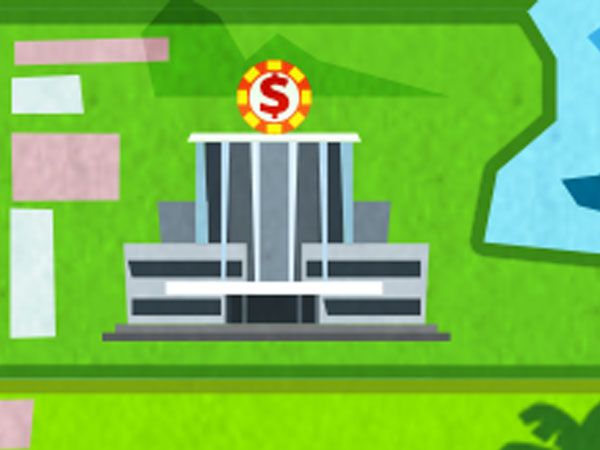 The last Landmark I want to talk about is the Casino. There actually isn’t a strong history of casinos in the Philippines that I know of, and until recently a government entity held the monopoly on casinos. So I did some preliminary research on casinos in Cuba and Latin America, trying to see if I could capture the Tropico vibe. Nothing really appealed to me so I kept digging around for Philippine architecture from the 50s, to see if there were any buildings with a modernist vibe that could stand in for a casino. What I found was the Jai Alai building. 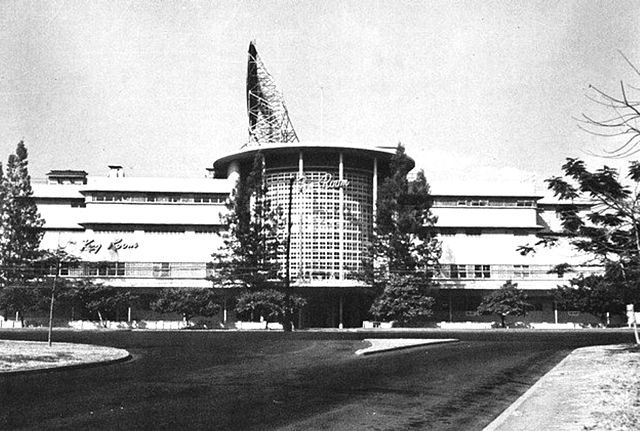 The Jai Alai building was a beautiful Streamline Moderne structure built in the 40s by architect Welton Becket. In it, wealthy citizens could bet on the Jai Alai players of their choice while dining in the luxurious Sky Room. The building somehow survived WWII and was refurbished by the US Army into a Red Cross Service Center. Eventually it returned to its gambling roots but by the 80s it had fallen into disrepair and was known as gathering place for hoodlums and criminal overlords. Sadly it was demolished in 2000 despite an outcry from heritage groups in the Philippines.  The seedy underworld reputation of the 80s Jai Alai building fits in perfectly with the Cat Kapitan, who is a thug that rose up from the streets to become a mafia kingpin. Loosely based on notorious local gangster Asiong Salonga, the Cat Kapitan is mostly interested in buying himself some legitimacy, and covering up his criminal roots. Welp, that’s about it for now. I hope I didn’t bore you with all of that information, but hopefully it will intrigue you and make you want to find out more about the world of Party Animals!
|
|
|
|
|
 Logged
Logged
|
|
|
|
|
|
|
|
|
ryansumo
|
 |
« Reply #28 on: May 13, 2014, 05:14:52 PM » |
|
Our programmer Julius teaches you how to win in Philippine Politics:Not all districts are created equal. Before the official campaign starts, your team should have already charted the "lay of the land" through an initial survey. This includes basic information like voting population and its demographics and candidate specific details like voter awareness and trust. TERRITORIESThe initial survey should reveal 3 types of territories: bailiwick, neutral, and hostile. Bailiwick - if election day is tomorrow you will win this district by a landslide. Half the voters here share your last name, you own a factory that employs half the voters, you saved this district from a tsunami, etc. Neutral - this district is a potential battleground. Specially if it has a high voting population. Neutralness could often be due to apathy, so voter education is also a must in this district. Hostile - this is the enemy's bailiwick. Expect to be heckled if you conduct a sortie here. Your campaign posters are likely to be torn the next day. The most effective solution against a hostile territory is voter apathy: "if I can't have your vote then no one else should". Historical data can also prove useful in predicting voting patterns. A district might have a high voting population but history might indicate that only a handful show up on election day. Such apathetic districts could be someone else's trump card if they manage to dispel voter apathy. Obama's election success has been attributed to the typically indifferent youth vote. The geographical data should dictate your campaign strategy. Which districts to focus on or neglect, which places need voter education, which to discourage voter turnout etc. CONCLUSIONThe resulting landscape would resemble a theatre of war. Thus the game won't be unlike your typical war game of capturing and defending territories. Personally this is what makes politics exciting, it's warfare minus the crudeness of death and killing. Well, most of the time anyway. This is also one of the big challenges of making a game about political campaigns, how do you make a war game fun without guns and killing ?
|
|
|
|
|
 Logged
Logged
|
|
|
|
|
ryansumo
|
 |
« Reply #29 on: May 28, 2014, 06:33:20 AM » |
|
Metaphors are a powerful tool that every piece of software can use to make something that is nebulous immediately understandable. Microsoft has used the desktop metaphor to such great success that the Metro-style sliding UI of Windows 8 is having a difficult time superseding it. Today I’ll talk about a visual metaphor that I hope will make Party Animals just as intuitive : The Itinerary. We’ve been tweaking the game design for the past few weeks now, something that has been made more difficult because of my knee injury. We still hadn’t comfortably nailed down how to manage the player’s movements and make their choices matter. AP (Action Points) were brought up as the standard way of doing this in strategy games, and while I felt it was a little too videogamey (there are no real world instances where “action points” dictate your movements) I had nothing better to contribute so I agreed. The MomentI’m going to go on a little tangent about how I came to the conclusion that the Itinerary metaphor would be the way we represented choice and movement in the game because I think it’s an important tool that every game developer or creative can find useful in their projects. There’s a noted correlation between letting your mind wander and coming up with great ideas. This passage from James Watt illustrates how letting his mind wander during a long walk led to the inspiration that birthed a vastly improved steam engine: Watt spent much time and money in making experiments, but nothing he tried succeeded. "Nature has a weak side," he was fond of saying, "if we can only find it out." So he went on day after day, following now this and now that false hope. "One Sunday afternoon early in 1765," writes Watt, "I had gone to take a walk in the Green of Glasgow. I was thinking upon the engine and about how to save the heat in the cylinder, when the idea came into my mind that steam was an elastic body and would run into a vacuum. If connection was made between the cylinder and a tank from which the air had been pumped, the steam would pass into the empty tank and might there be condensed without cooling the cylinder. I then saw that I must get rid of the condensed steam and of the water used in condensing it. It occurred to me this could be done by using pumps." That mind-wandering walk along the Green of Glasgow unleashed the power of steam and let loose the industrial revolution. Centuries later it would also birth, for good or ill, the genre called Steampunk. Our ideas will likely never be as influential as Mr. Watts’, but there’s not reason we can’t mind-wander for our own projects. It’s important to note that you’ll only come to ideas if you are already thinking of and absorbing material about the problem that you’re trying to solve. My own method is to just try to bury myself in stuff related to a topic and hope that something comes to me. In this case since we’re making a game about politics I tried to watch as many shows, play as many games, and read as many books as I can about politics. I naturally find politics interesting so this wasn’t a tall order for me. Shows like The Wire and Parks and Recreation are highly recommended, and I thoroughly enjoyed my time playing Tropico and Democracy 3.  Julius also likes shows about politics, and in one of our meetings he suggested I watch the TV show Veep to get ideas for the game. There was a scene in the second episode where the cast was discussing the schedule for the day because people kept cancelling meetings because they were sick. It’s not a key part of the storyline, and I didn’t think much of it until a couple of days later. I had my wife rewatch the first two episodes so that she could get caught up and we could watch together, and somewhere in between overhearing snippets of dialogue that day and waking up the next day I had my epiphany. What’s On the Itinerary?What’s on the itinerary? What’s on the docket? What’s my schedule looking like? These are questions any high powered executive, lifehacker devotee, or presidential aspirant might ask. Time and money are the most valuable resources in a campaign. Time has to be managed even more carefully than money because while money can always be found (not on trees, though) wasted time is lost forever. So it makes absolute sense to frame actions in the game around managing that most important of resources. As I alluded to earlier another advantage of using this metaphor is that it’s immediately understandable. Everyone has had to schedule their day at one point or another. The datebook I pulled off Google images is also a visual metaphor that most people in their 20s and above would recognize. It’s definitely easier to explain to people that they need to “add activities to their itinerary” rather than “each activity costs x AP”. Anything that makes a strategy game easier to understand is a winner in my book. Activities There are two types of activities : regular and geographical. Regular activities can be done anytime whilst Geographic activities can only take place based on your location. For example in this screen you can see that the player is allowed to do the gamble activity, which lets the player spend campaign funds in an attempt to earn more via a slot machine (An obvious test of player morality). Having geographical activities also makes it more interesting for the player to move around the map. I rather enjoy making maps, and part of the fun when I travel is poring over maps of an area and imagining what it might be like. I’d like to impart some of the fun of that sense of discovery by adding more structures on the map that we can use to increase the number of activities that the player can engage in. Additional structures that we can add to the map that might have activities would be : Radio station, TV station, Printing Press, Hospital, etc. As you can see here each activity also take a specific amount of time. The challenge of the game (and any campaign) will be to judge which activities will give you the best value for money/time. In this case a Photo Op would be a pretty standard go to activity in the beginning of the game, since it would provides a small increase in popularity for a small amount of time/money. Meeting the Kapitan is riskier, since the results will depend on your conversation with them. Why does it take so much time? Because in people with power will make you wait as a sign of dominance over you. The last activity is “Move”. In most games moving from one area to another is almost incidental. there is no cost to travel. In our game we wanted to make sure that movement comes with a price and should be a planned decision. Since it costs so much to move you must ask yourself what the advantages are to moving to another district versus staying in the same one. It’s also a subtle jab at the pitiful infrastructure in the Philippines, where it can literally take half a day to get to a neighbouring city or province. Party AnimalsOriginally, we named our game “Party Animals” because it was a play on words. We wanted to make a political game with cute animals that ostensibly belonged to political parties. We introduced the Kapitans as a way of extending that metaphor, but it still felt a little hollow to me. Then over some email exchanges we floated the idea of collecting Animals and adding them to your party. These animals would join you based on metrics like your morality and your connections to Kapitans, and would have an effect on your campaign sorties. I really liked the idea of collecting “Party Animals” and I realized that there was a terrific way to tie them into the itinerary metaphor. As I mentioned before, there are regular and geographic activities. But now if you recruit a Party Animal to your cause, it unlocks special activities tied to them. For example, an athlete Animal would let you run a sports clinic. An accountant Animal could run the “Audit” activity which would streamline your fundraising and improve funds collection for a few turns. The number of interesting and useful characters we could create is endless. Of course the terrifying thought is that means I would have to design and illustrate each of those characters, not to mention giving them backstories. ConclusionIt can be very frustrating when parts of a game design don’t gel together properly. In this particular case I think that framing the game with this itinerary metaphor really helped to clarify things in my head and I’m hopeful that this helps shape the game moving forward! |
|
|
|
|
 Logged
Logged
|
|
|
|
|
Greipur
|
 |
« Reply #30 on: May 28, 2014, 08:10:16 AM » |
|
I love the idea, both aesthetics and art direction. Looking forward to try it out in the future.
|
|
|
|
|
 Logged
Logged
|
|
|
|
|
ryansumo
|
 |
« Reply #31 on: May 28, 2014, 04:06:28 PM » |
|
Thanks! We're hoping to have something playable within the next few months. If you signup for our mailing list you'll be one of the first to know!
|
|
|
|
|
 Logged
Logged
|
|
|
|
|
ryansumo
|
 |
« Reply #32 on: June 07, 2014, 05:16:56 AM » |
|
Just a quick update, back to doing concept sketches of characters. this one's Dr. Macaque! |
|
|
|
|
 Logged
Logged
|
|
|
|
|
ryansumo
|
 |
« Reply #33 on: July 11, 2014, 06:56:36 PM » |
|
Hey all been a while since we last updated. Since then we've continued to work on characters, including Franciscrow, the Private Investigator you see above. He's a disgraced former Police Chief turned Private Investigator. Franciscrow's looking for revenge on the upstart detective that ratted him out and became Police Chief in his stead. In meantime, he's willing to dig up dirt on your rivals and give you information on how to win over the Kapitans...for a price. I've also worked on some fun little animation for our districts, as well as giving them a popup look that most people seem to like. This is an animation for our Fishing Village. We're also going back to the drawing board and creating a basic prototype that incorporates most of our ideas in a smaller scale, to see if it really works together as a package. Here is our Kapitans screen, which gives you info on the Kapitans and their relationships with each other. If you're interested in being one of the first people to try out and comment on the prototype, please do sign up for our mailing list! |
|
|
|
|
 Logged
Logged
|
|
|
|
|
ryansumo
|
 |
« Reply #34 on: August 16, 2014, 05:18:21 PM » |
|
Hi all, after going back to the drawing board we finally have a prototype that we'd like some feedback on. We'd really appreciate it if you guys tried out the game and let us know what you think! http://playpartyanimals.com/ |
|
|
|
|
 Logged
Logged
|
|
|
|
|
ephoete
|
 |
« Reply #35 on: August 17, 2014, 02:28:15 PM » |
|
Ah finally. I'll be doing real-time comments: 1) Select your HQ. What's "pi" exactly? What do "very high" "very low" mean? Ok there's a tooltip when you get the mouse over it. Don't really understand what will be the "aftermaths" of having chosen education and employment as my first priorities. 2) First contact with the interface, this looks quite complicated. I'm lost and I don't know what I'm supposed to do now. Not sure I got it right but I guess I'm supposed to control Mousey's election. Not sure what's the meaning of these 6 areas. Are there the quarters of the same town? What are these guys that appear on top of the figures when you switch between areas? 3) Still lost so I clicked on Kapitans. Ok it seems to give me info about potential allegiances I assume. Fiddling about with the graph albeit not sure to understand what's the purpose here but it's fun for a while. 4) Ok perhaps I start to get it. There are some folks here who've got their own circle of influences and I'd better befriend with them before my opponent. I can also do other activities that will influence the survey in good or bad. 5) Ok trying something finally. Ok there are tooltips here as well. It's talking about risks but almost never about rewards or what these actions could imply on my survey. It's quite abstract to understand what bribe will do but I'll try this one first. 6) Ah ok so I'm actually only planning my agenda for now, it doesn't trigger any action. Ok let's plan the first day then... but hard to do since I've no idea what all these actions imply. 7) Ok planned some stuff and clicked on go... and have to click on Start now (!).  Ok my bribery attempt failed (why?!). Ok getting through my agenda, now apparently I've to talk with Mr. Pelicarpio. Apparently missed to make it eventful. Ok then I bought a van to a guy... and it was also uneventful too. 9) Alright second day, didn't see any changes in the survey. I'll go through the entire sprint now. 10) The money goes away incredibly fast! Already lost 3/4 in 3 days. 11) The priest asks me $5000 it's nonsense! 12) Day 9, could only afford moving to the next area, too bad. 13) Half way and really running out of money. Realized there are several icons on the map but I've no idea what they mean. Oh ok there's a typhoon! 14) Don't get what sortie means. It brings points but I don't understand what for. 15) I'm broke! Ok apparently it doesn't matter at all. The ratio between my opponent and I fluctuates a lot every day. 16) Final day preparation. Ok I can choose to support the Kapitans, I've no idea what it means though. Well I'm broke but it doesn't mean anything so I decide to support most of them. 17) Ok something is going on but I don't understand what. But apparently I'm the mayor! Verdict! This is fine but a small tutorial at the beginning and more explanations on what's going on from time to time would be appreciated. I think the cashflow isn't very well-balanced in the game... But I win!  |
|
|
|
|
 Logged
Logged
|
|
|
|
|
ryansumo
|
 |
« Reply #36 on: August 17, 2014, 07:26:41 PM » |
|
Thanks so much for the feedback! It's been a long time coming for this prototype because we made so many mistakes along the way and we're still making them. Our result from this round of testing is that it seems the long term game is interesting enough, especially for strategy players (I posted in the paradoxplaza reddit) but there is definitely a lot of confusion in the middle and no short term game loop that entices players to keep moving. It's definitely back to the drawing board for us but we've got a lot of ideas to make it better!
|
|
|
|
|
 Logged
Logged
|
|
|
|
|
ryansumo
|
 |
« Reply #37 on: September 20, 2014, 05:51:12 PM » |
|
The mockup (and I must stress it is just a mockup) above should be familiar to anyone who's played Crusader Kings 2 or indeed any game that used Paradox Interactive's Clausewitz Engine. In this blog post I'm going to go over some of the new directions our next prototype is going to go, taking a lot of inspiration from the aforementioned games. Prototyping is all about figuring out what works and what doesn't. this is something we're learning the hard way by prototyping our way to a version of Party Animals that we're happy with. After we released the first prototype last month for feedback, we had another meeting at the Glorietta 4 food court and decided on a few changes. Adding Campaign StaffWe'd discussed the idea of recruiting "Party Animals" into your campaign before, but we decided to give them a more prominent role in this new prototype. Instead of all the actions being taken by your candidate, you now have campaign staff that can travel around the island to do actions for you. This gives the player a lot more flexibility in terms of decisions. Whereas in the previous prototype the player was restricted to doing actions only in the district where they were located, now your staff can prepare a district for your arrival even while you're conducting a campaign in a far off district. This means a wider range of strategic options, which is ultimately more entertaining. Additionally having the staff front and center plays to the name of the game. Choosing the right "Party Animals" now becomes central to your strategy. Getting rid of the itineraryWhile I thought that the itinerary system was quite clever and fit the theme of the game very well, it became quickly apparent that filling out a scheduling form is just as boring in games as it is in real life. It also introduced difficulties when trying to reconcile it with the addition of campaign staff, so we ultimately decided it wasn't worth keeping. We're replacing it with a much simpler calendar that tracks the time it will take for actions to resolve. Shifting towards a strategy audienceIf Paradox Interactive's motto is to make "smart games for smart people" we went into Party Animals wanting to make "smart games for regular people", the idea being to combine the depth of the games we love with a more humorous, approachable look and feel. When combining two disparate elements there's always a risk that you will end up with a product that pleases no one, and we noticed that with the first prototype there was strong polarization between people that liked it or were bored by the game. The people who really seemed intrigued by it were the kind folks on the paradoxplaza subreddit who if anything thought the game was too simple. So we're shifting towards that audience by creating the deeper, more strategic gameplay that they enjoy. Prototype v2 out soon! |
|
|
|
|
 Logged
Logged
|
|
|
|
|
ryansumo
|
 |
« Reply #38 on: December 01, 2014, 05:52:27 AM » |
|
Hoo boy, it's certainly been a while since I last posted here. Lots of stuff happened in between, and you can find out a little more by going to our blog http://blog.heypartyanimals.com/2014/09/ive-got-some-good-news-and-some-bad-news.html (saves me the effort of posting here). In the meantime I'd appreciate any feedback you guys may have on our updated map above, Thanks in advance for any feedback! |
|
|
|
|
 Logged
Logged
|
|
|
|
|
ryansumo
|
 |
« Reply #39 on: February 06, 2015, 05:52:34 PM » |
|
Once again it's been a while since I've posted. We'll have some more updates within the next few months, but in the meantime here's a tiny GIF! |
|
|
|
|
 Logged
Logged
|
|
|
|
|
 Community
Community DevLogs
DevLogs Party Animals! - A Deceptively Cute Political Strategy Game (PC)
Party Animals! - A Deceptively Cute Political Strategy Game (PC) Community
Community DevLogs
DevLogs Party Animals! - A Deceptively Cute Political Strategy Game (PC)
Party Animals! - A Deceptively Cute Political Strategy Game (PC)
